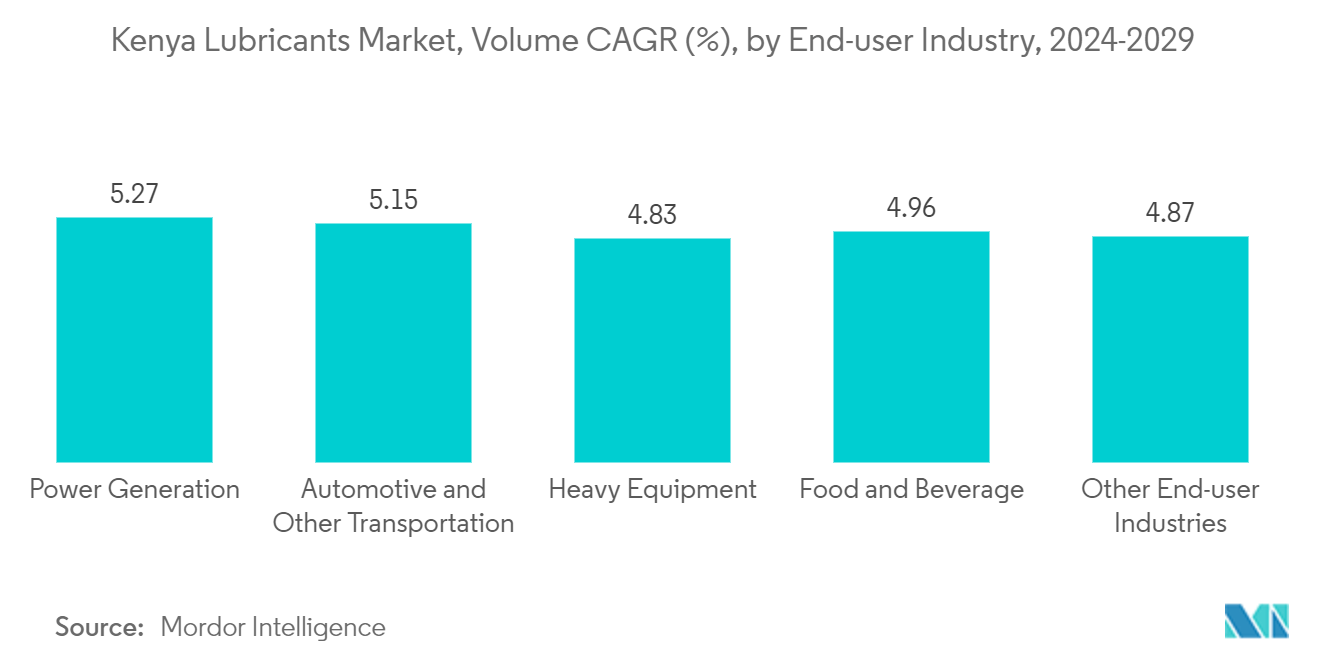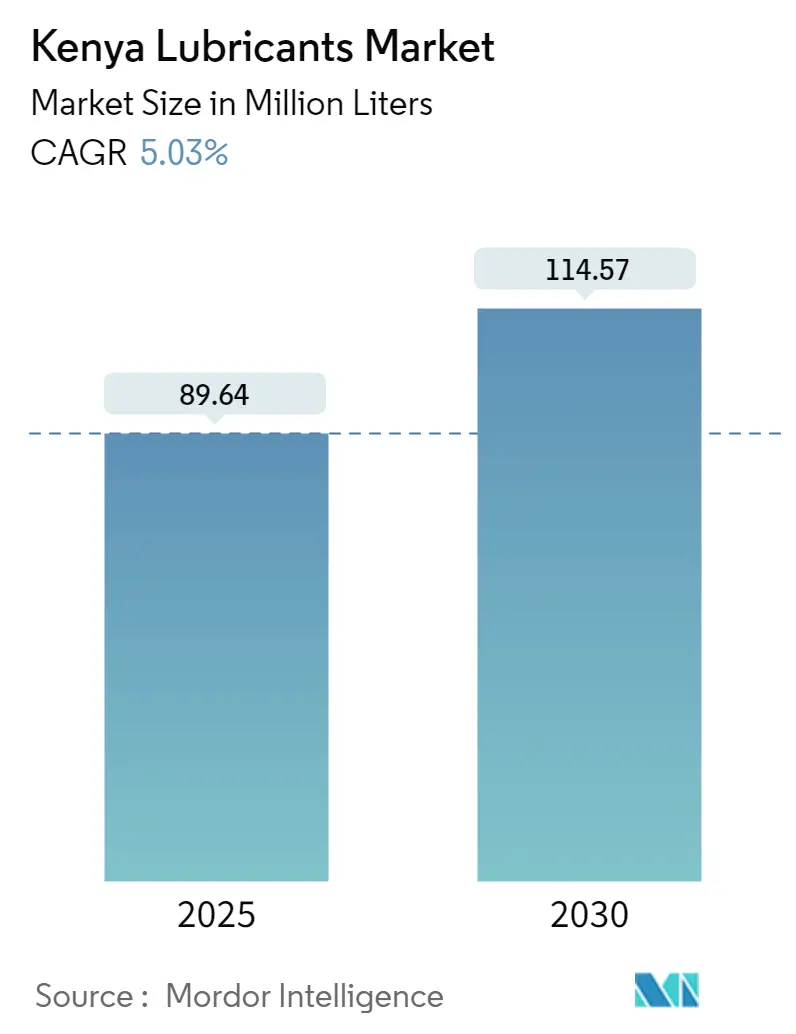
| Study Period | 2019 - 2030 |
| Base Year For Estimation | 2024 |
| Forecast Data Period | 2025 - 2030 |
| Market Volume (2025) | 89.64 Million liters |
| Market Volume (2030) | 114.57 Million liters |
| CAGR | 5.03 % |
| Market Concentration | High |
Major Players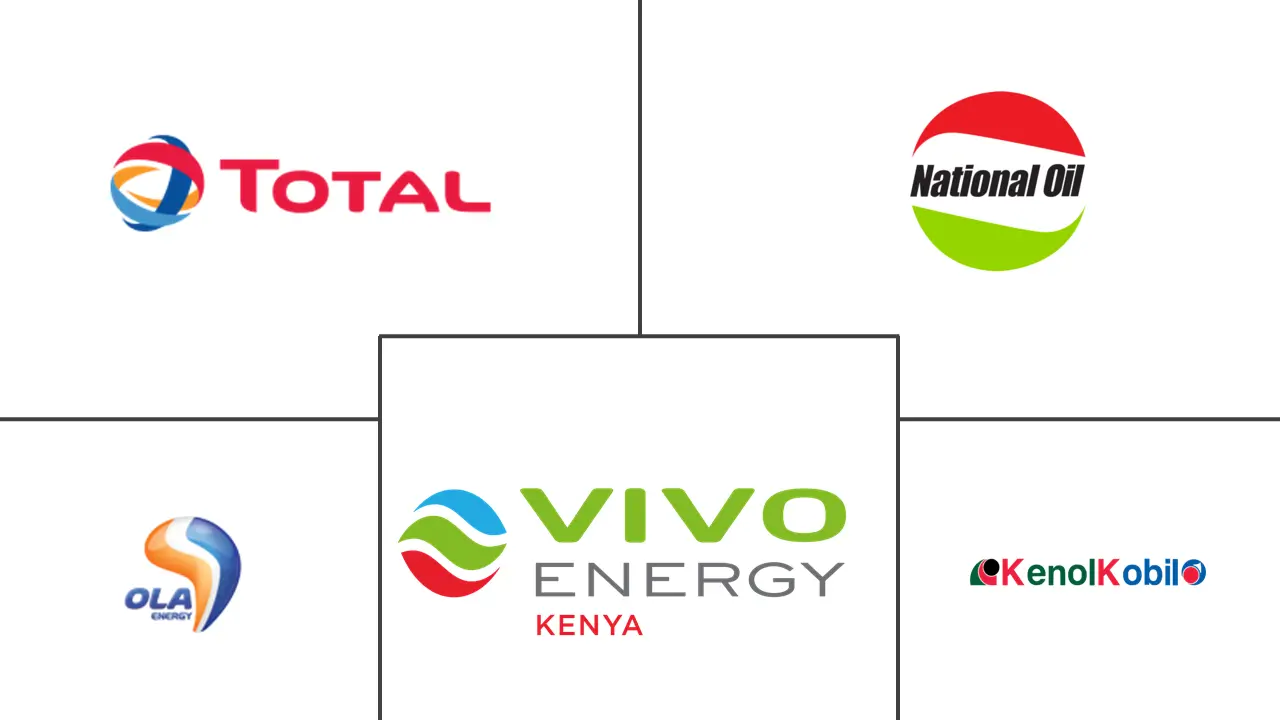
*Disclaimer: Major Players sorted in no particular order |
Kenya Lubricants Market Analysis
The Kenya Lubricants Market size is estimated at 89.64 million liters in 2025, and is expected to reach 114.57 million liters by 2030, at a CAGR of 5.03% during the forecast period (2025-2030).
The COVID-19 pandemic negatively impacted the market in 2020 because it significantly impacted supply chains and caused several supply chain disruptions that led to production halts and other issues in almost all industries, such as automotive, heavy equipment, etc. New car sales in the country increased in 2021 as economic growth rebounded from a pandemic-induced slump the previous year, driving up demand. This had a positive impact on the lubricants market in the country. The condition is expected to surge in 2022, benefitting the market studied.
- Increasing demand from industrial and construction segments for lubricants to drive the market growth.
- The widespread presence of counterfeit and substandard lubricants in Kenya is expected to hinder market growth.
- Investments in power generation and the automotive sector will likely create a lucrative growth opportunity for the studied market.
Kenya Lubricants Market Trends
The Dominance of Engine Oils in the Market
- Engine oil, or engine lubricant, is one of the various substances used to lubricate internal combustion engines to ensure good performance. Engine oil can be synthetic, mineral, or semi-synthetic in nature but is always made of a unique composition of base oil and additives.
- Mineral engine oils are derived from crude petroleum and contain hydrocarbon, oxygenated or non-oxygenated, and may also contain sulfur or nitrogen. Synthetic oils are created chemically in the laboratory but can also come from refined petroleum. The composition and production complexity of synthetic oils makes them high-end oils with higher performance compared to mineral oils. Semi-synthetic oils are a mixture of synthetic and mineral oils, but different semi-synthetic products may have different mix compositions.
- The engine oil product type dominates the lubricants market in the country because of the high demand from the transportation or automotive end-user industry. All kinds of vehicles with a combustion engine require engine oil to function properly and to ensure a long life.
- According to Waverley Exhaust & Brake, most auto manufacturers recommend engine oil changes once each year or 20,000 km on petrol engines, while diesel engines and turbocharged petrol engines should be changed every 6 months or 10,000 km.
- Moreover, the current automotive market in the country is dominated by vehicles based on internal combustion engines that use either gasoline or diesel or are hybrid in nature. This simultaneously indicates a high volume demand for engine oils or engine lubricants across the country.
- Additionally, the country has a large market for used cars as they have always been a cheaper alternative to buying a new car. According to JapaneseCarTrade.com, used cars account for more than 80% of all vehicles sold in Kenya, and there is great demand for used passenger vehicles in the country.
- This can lead to a further increase in demand for engine oils and help it sustain its dominance in the market because as the engine of a vehicle starts to get old, its engine oil demand also increases gradually.
Increasing Usage in Automotive and Other Transportation
- Lubricants such as engine oils, transmission fluids, Hydraulic fluids, Gear oils, and grease are used in various automotive applications to prevent them from wear and tear.
- Due to the increase in urbanization in Kenya, the demand for automobiles has been growing.
- According to the Kenya National Bureau of Statistics, the production of assembled vehicles increased from 1,114 units in February 2022 to 1,154 units in March 2022.
- According to AutosKenya, the sale of newly manufactured vehicles in the first three months of 2022 accounted for 3,203 units, which was 367 units more than what was sold in the first three months of last year.
- However, according to Kenya Motor Industry Association (KMIA), new motor vehicle sales for the nine months to September 2023 dropped 12.3% compared to 2022 because the dealers in the country sold a total of 8,715 units between January and September, compared to 9,936 units sold during the same period in 2022.
- Kenya's government plans to boost the domestic assembly of motor vehicles by providing tax exemptions. This, in turn, is expected to increase the local vehicle assembly operations in Kenya in the coming years.
- Increase in the usage of secondhand cars and various government schemes to encourage the automotive segment in the country. The lubricant market is expected to rise in the forecasted years.
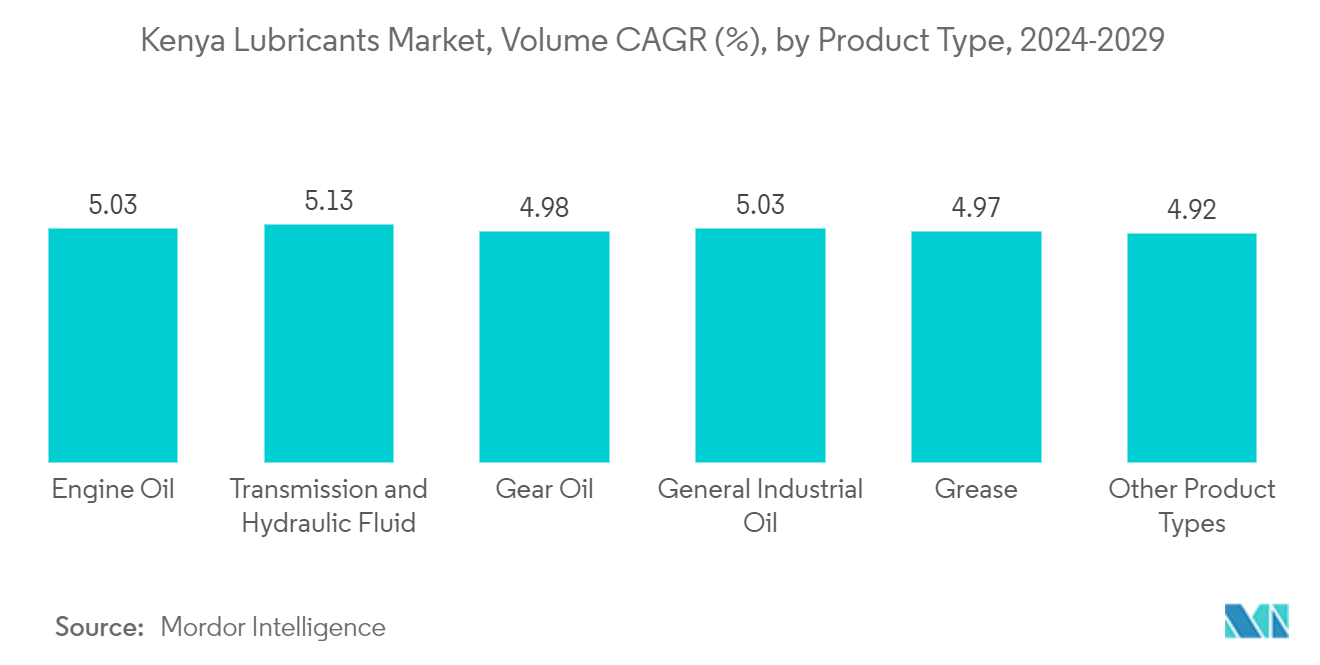
Kenya Lubricants Industry Overview
Kenya's lubricant market is consolidated in nature, with very few major players occupying a large portion of the market. Some of the major companies (not in any particular order) are TotalEnergies Marketing Kenya PLC, Vivo Energy (Shell), OLA Energy, Kenol & Kobil, and National Oil Corporation of Kenya, Energizing Kenya, among others.
Kenya Lubricants Market Leaders
-
Vivo Energy (Shell)
-
OLA Energy
-
TotalEnergies Marketing Kenya PLC
-
National Oil Corporation of Kenya, Energizing Kenya
-
Kenol & Kobil
- *Disclaimer: Major Players sorted in no particular order
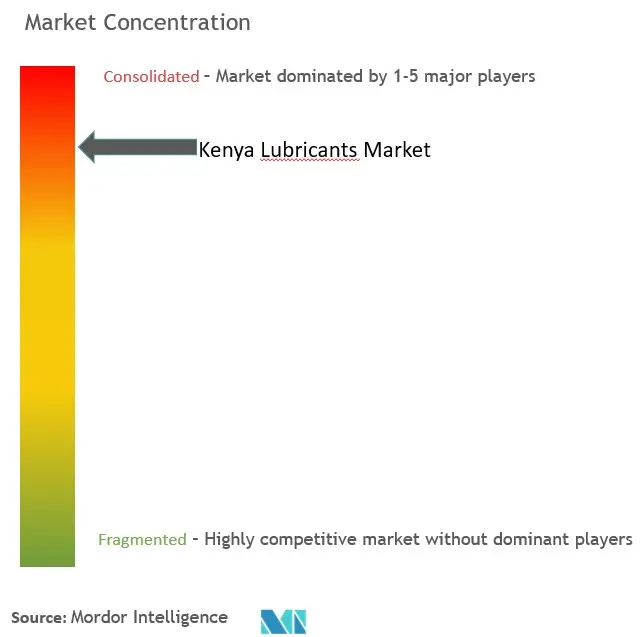
Kenya Lubricants Market News
- November 2023: Kenya’s National Treasury planned to privatize 11 state-owned Kenyan companies, among which the National Oil Corporation of Kenya (NOCK) and the Kenya Pipeline Company (KPC).
- May 2023: India's flagship overseas oil firm ONGC Videsh got a new partner in Oil India Ltd. to replace a reluctant IndianOil (IOC) for the potential acquisition of a 50% stake in Tullow Oil Plc's USD 3.4 billion oilfield project in Kenya. But the OVL-OIL duo might have to face competition from Sinopec, which entered the fray taking advantage of the delay on the Indian part in finalizing the deal.
- February 2023: Vivo Energy in Kenya agreed to purchase a 74% stake in Engen Limited from PETRONAS International Corporation Ltd. to expand its market presence in Kenya, increase its revenue, and widen its lead over competitors TotalEnergies and Rubis.
- September 2022: Maximus Group planned to acquire a 49% stake in Kenya-based Quantum Lubricants. Earlier, in 2019, MXAL acquired a 51 percent equity stake in QLL, which paved its entry into lubricant manufacturing in the African markets. With the ongoing acquisition of 49%, MXAL is expected to take control of QLL's entire operations.
Kenya Lubricants Industry Segmentation
Lubricant products are made from a combination of base oils and additives. The composition of base oil in the formulation of lubricants is primarily between 75-90%. Base oils possess lubricating properties and make up 90% of the final lubricant product.
The market is segmented by product type and end-user industry. By product type, the market is segmented by engine oils, transmission and hydraulic fluids, gear oils, general industrial oils, greases, and other product types (dry film lubricants, etc.). By end-user industry, the market is segmented by power generation, automotive and other transportation, heavy equipment, food and beverage, and other end-user industries.
For each segment, the market sizing and forecasts have been done based on volume (liters).
| Product Type | Engine Oils |
| Transmission and Hydraulic Fluids | |
| Gear Oils | |
| General Industrial Oils | |
| Greases | |
| Other Product Types | |
| End-user Industry | Power Generation |
| Automotive and Other Transportation | |
| Heavy Equipment | |
| Food and Beverage | |
| Other End-user Industries |
Kenya Lubricants Market Research FAQs
How big is the Kenya Lubricants Market?
The Kenya Lubricants Market size is expected to reach 89.64 million liters in 2025 and grow at a CAGR of 5.03% to reach 114.57 million liters by 2030.
What is the current Kenya Lubricants Market size?
In 2025, the Kenya Lubricants Market size is expected to reach 89.64 million liters.
Who are the key players in Kenya Lubricants Market?
Vivo Energy (Shell), OLA Energy, TotalEnergies Marketing Kenya PLC, National Oil Corporation of Kenya, Energizing Kenya and Kenol & Kobil are the major companies operating in the Kenya Lubricants Market.
What years does this Kenya Lubricants Market cover, and what was the market size in 2024?
In 2024, the Kenya Lubricants Market size was estimated at 85.13 million liters. The report covers the Kenya Lubricants Market historical market size for years: 2019, 2020, 2021, 2022, 2023 and 2024. The report also forecasts the Kenya Lubricants Market size for years: 2025, 2026, 2027, 2028, 2029 and 2030.
Our Best Selling Reports
Lubricants in Kenya Industry Report
Statistics for the 2025 Kenya Lubricants market share, size and revenue growth rate, created by Mordor Intelligence™ Industry Reports. Kenya Lubricants analysis includes a market forecast outlook for 2025 to 2030 and historical overview. Get a sample of this industry analysis as a free report PDF download.



